Turmeric and Skin: 5 Ways Turmeric Root Is Used to Help Protect & Heal Skin
In a hurry? Click here to read the Article Summary...
Turmeric (known scientifically as Curcuma longa) is an earthy root spice belonging to the ginger family. Believed to have been originally cultivated in India and Indonesia, turmeric is widely used for cooking, dyeing fabrics, and cosmetics. Turmeric is very popular at the moment for its potent health-giving benefits… but turmeric’s use actually dates back centuries.
Indeed, turmeric has long been used in Ayurveda, the traditional Indian system of medicine. Some of the traditional uses of turmeric in Ayurveda include:
- Helping to maintain healthy levels of gut bacteria
- Protecting against stomach disorders
- Helping to cleanse the liver and increase the flow of bile, necessary for breaking down dietary fats during digestion
- Helping to manage blood sugar
- Helping to support a body plagued with arthritis inflammation and pain.
Turmeric and Skin: Ayurveda’s Traditional Uses
According to the ancient Ayurvedic text the Charaka Samhita, turmeric’s ability to manage inflammation levels in the body is the reason why it benefits so many health conditions – including those affecting the skin.
For example, the juice of turmeric was used to help heal wounds, bruises, and leech bites. A paste made of turmeric alone or with neem leaves was used to treat ringworm, itching, eczema, and many other parasitic skin conditions.
Hemorrhoids (piles) were treated by Ayurvedic healers with an ointment of turmeric, hemp leaves, onions, and warm mustard oil or linseed oil, applied externally.
Pastes of turmeric were used to relieve skin itching and ulcers during infections of smallpox, chickenpox, and shingles, and also to treat various skin blemishes.
Ayurveda and Skin
Turmeric has long been used by traditional Ayurvedic healers to treat skin conditions in the form of creams, lotions, pastes, and ointments. However it’s not just the traditionalists who believe in turmeric’s effectiveness for treating skin conditions. Modern scientific and clinical evidence indicates that turmeric can potentially be effective with:
- reversing some of the skin damage caused by the sun and UV light (known as photoaging)
- protecting against skin itching or pruritus
- reducing the severity of the damage caused by radiation therapy (radiation dermatitis)
- helping to manage psoriasis
- helping to prevent fungal skin conditions
5 Ways Turmeric Has Scientifically Been Shown to Improve Skin
Let’s take a closer look at 5 reported beneficial applications for turmeric and skin…
#1. Reversing Facial Photoaging
 Photoaging is a term used to describe premature aging of the skin caused by repeated exposure to ultraviolet radiation (UV) – mainly from the sun, but also from artificial UV sources.
Photoaging is a term used to describe premature aging of the skin caused by repeated exposure to ultraviolet radiation (UV) – mainly from the sun, but also from artificial UV sources.
Photoaged skin typically shows areas of greater pigmentation and becomes thin and easily damaged.
A randomized, placebo-controlled, double-blind study conducted in 2007 evaluated the efficacy of Tricutan – a herbal combination gel containing turmeric, rosemary, and gotu kola – in improving skin firmness and elasticity and improving the signs of photoaging in 25 women aged between 34 to 67 years.
Rosemary is believed to moisturize skin, support healthy collagen development, and counter skin-damaging free radicals. Gotu kola, also known as Indian pennywort, has long been used to heal wounds and treat skin conditions such as leprosy and psoriasis for thousands of years in India, China, and Indonesia.
The results of this 4-week study showed that treatment with Tricutan gel improved skin firmness and clinical evaluation in the women being tested. Further, according to their self-evaluation, the participants felt that Tricutan gel gave significantly better results than the control.
Unfortunately, a major limitation of this study is that the potential benefits of turmeric cannot be separated from those potentially caused by rosemary and gotu kola.
However, curcumin (one of the main active compounds in turmeric) has been shown to block an enzyme in our body known as phosphorylase kinase, with beneficial effects for many skin conditions including burns and photoaging. For instance, a 2013 study showed that curcumin gel helps to heal burns rapidly, with little or no residual scarring.
Additionally, the gel also helped to reverse many of the adverse changes seen in photo-damaged skin, suggesting that curcumin could be used as an effective, natural, and non-toxic ingredient in sunscreen creams and lotions.
#2. Protection Against Itching
Pruritus is the scientific term used to describe severe itching, which can happen because of many underlying causes. For instance, uremic pruritus is caused by chronic kidney disease. Uremia means having excessive urea in the blood, which occurs when both kidneys stop working – which is known as renal failure.
In a randomized, double-blind, placebo-controlled study conducted in 2014, 100 dialysis subjects with uremic pruritus were given either three turmeric capsules daily or control starch capsules for 8 weeks. At the end of the study, the researchers found that dialysis subjects in the curcumin group experienced significantly less itching relative to subjects in the control group.
Simultaneously, they also found that curcumin significantly reduced the levels of high-sensitivity C-reactive protein (known scientifically as hs-CRP), a well-known marker of inflammation.
 Exposure to sulphur mustard severely damages the skin, typically leading to severe pruritus. In a 2012 study, 96 male subjects with sulfur mustard-induced pruritus were given either one gram of curcumin or placebo capsules daily for 4 weeks, while being constantly evaluated for pruritus severity using three different assessment methods.
Exposure to sulphur mustard severely damages the skin, typically leading to severe pruritus. In a 2012 study, 96 male subjects with sulfur mustard-induced pruritus were given either one gram of curcumin or placebo capsules daily for 4 weeks, while being constantly evaluated for pruritus severity using three different assessment methods.
At the end of the study, the researchers reported that the curcumin group showed a significant reduction in pruritus severity, as measured by all three methods of assessment.
Further, the levels of substance P, a strong stimulator of pruritus, was seen to be significantly reduced in the curcumin group compared with the placebo group. At the same time, the innate antioxidant enzymes superoxide dismutase, glutathione peroxidase, and catalase were seen to be higher in the curcumin group relative to placebo.
In other words, turmeric consumption increased levels of natural antioxidant enzyme systems.
Similarly, another 2012 study looked at the effects of curcumin on various inflammatory markers in the blood of 96 male Iranian war veterans suffering from chronic sulphur mustard-induced pruritic skin lesions.
These men were randomly given either one gram of curcumin or control daily for four weeks. At the end of the study, inflammatory markers such as interleukin-8 (known scientifically as IL-8 and an important component of the immune system) and high-sensitivity C-reactive protein (hs-CRP) were significantly lower in the group being treated with curcumin, suggesting that curcumin can reduce sulphur mustard-induced pruritic complications – and likely other forms of pruritus – by helping to support healthy inflammation levels.
#3. Reducing Severity of Radiation Dermatitis
Radiation therapy is a widely accepted form of conventional medical treatment. Unfortunately, it causes severe side effects and can reduce both quality of life and long-term survival.
One very common side effect of radiation therapy is dermatitis, also known as eczema – which is typically characterized by itchiness, red skin, and a rash, usually on very specific areas of the skin and sometimes over the entire body.
Up to 85 percent of all patients undergoing radiation therapy are likely to experience moderate to severe skin reactions within a few days to weeks, which increase after 2 to 3 weeks and continue to build up as radiation therapy goes on.
Radiation dermatitis (also known as radiodermatitis, x-ray dermatitis, radiation skin damage, or a radiation burn) varies in severity from person to person. Symptoms such as dry skin, itching, discomfort, pain, warmth, and burning have been reported for up to 4 weeks after radiation treatment has ended.
Redness of the skin or mucous membranes caused by greater blood flow in delicate blood vessels just under the skin known as capillaries has also been known to happen. Management of radiation dermatitis is crucial, as this can help to improve the therapeutic benefits of radiation therapy, prevent infections, and reduce skin injury and scarring.
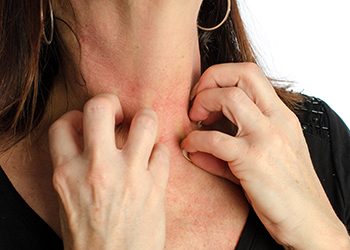
Currently there is no effective standard treatment to prevent or treat radiation skin dermatitis.
Promisingly, the curcumin in turmeric has been shown to be helpful in various skin conditions, including radiation dermatitis.
For instance, in 2013, a randomized, double-blind, placebo-controlled clinical study was conducted in 30 patients to assess the ability of curcumin to manage radiation dermatitis. Randomized patients were given either 2 grams of curcumin or control orally in capsule form three times daily – in other words, a total of 6 grams every day – throughout the course of radiation therapy, which lasted between 16 to 33 sessions.
At the end of the study, the researchers concluded that orally given curcumin significantly reduced severity of radiation dermatitis and a condition known as moist desquamation after radiation therapy.
Moist desquamation is a skin condition that happens as a consequence of radiation exposure in which the skin thins and begins to weep, or ooze liquid, because of a weakening of skin structure.
The study researchers further stated that “it is possible that a higher oral dose of curcumin, such as ≥8.0 grams daily, may be more effective against radiation dermatitis severity including erythema and skin reactions.”
In 2014, another study was undertaken jointly at Father Muller Medical College in Mangalore, India, and the University of South Carolina in Columbia, SC, to assess the effectiveness of a popular, commercially available herbal-based skin cream for preventing severe dermatitis in patients requiring radiation therapy. This cream contains turmeric and sandalwood oil and has been used in India for over 40 years to enhance the complexion and rejuvenate the skin.
As radiation therapy proceeded, signs of skin damage began to appear in the third week. Roughly 20 percent of the volunteers in the control group and 8 percent of the patients in the cream-treated group developed dermatitis.
Continuation of radiation treatment into the fourth week increased the incidence of dermatitis to 75 percent for the control group and only 37.5 percent in the cream-treated group – a statistically significant difference.
Both incidence of dermatitis and the degree increased in both groups in subsequent weeks, reaching a peak at week 7.
However, a direct comparison showed that patients using the turmeric and sandalwood cream had a significantly delayed appearance and reduced levels of dermatitis at all time points during radiation therapy.
While these initial studies are very promising, larger clinical trials are needed to assess the extent of turmeric’s effectiveness in helping to manage radiation dermatitis.
#4. Management of Psoriasis
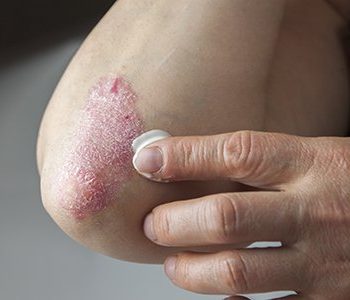 Psoriasis is a persistent yet unpredictable skin disorder in which skin cells grow up to 10 times faster than normal.
Psoriasis is a persistent yet unpredictable skin disorder in which skin cells grow up to 10 times faster than normal.
As underlying cells reach the skin’s surface and die, their sheer numbers lead to raised, red plaques covered with white scales – typically seen on the knees, elbows, and scalp, although it can also affect the torso, palms, and soles of the feet.
Plaque psoriasis, the most common form of this condition, includes symptoms such as red skin, often covered with loose, silver-colored scales. These lesions may be itchy and painful, and sometimes they also crack and bleed.
In laboratory studies, turmeric has been shown to block many of the inflammatory enzymes involved in triggering psoriasis.
In a randomized, prospective placebo-controlled, double-blind clinical trial conducted in 2015, the efficacy and safety of an externally applied turmeric microemulgel was assessed on 34 patients suffering from mild to moderate plaque psoriasis.
The results of this study show that the clinical and quality of life parameters in patients treated with the turmeric microemulgel were significantly better relative to patients with untreated lesions. Further, observed side effects of treatment were trivial.
These results appear to indicate that gels and creams containing turmeric may be an effective and safe way of helping to manage psoriasis symptoms.
#5. Helping to Stop Fungal Skin Conditions
Turmeric is widely used in Thai traditional medicine for treating rash, itching, ringworm, athlete’s foot, and jock itch. Previous studies have reported that turmeric oil as well as multiple curcuminoid compounds are effective against various species of dermatophytes, a type of fungus that causes skin diseases.
For instance, in a 2013 study, two turmeric creams containing 6 and 10 percent turmeric oil were tested against various types of dermatophytes. Ar-turmerone, a potent compound present in turmeric oil, was seen to be effective against dermatophytes, although further studies are needed to assess the safety and stability of this compound.
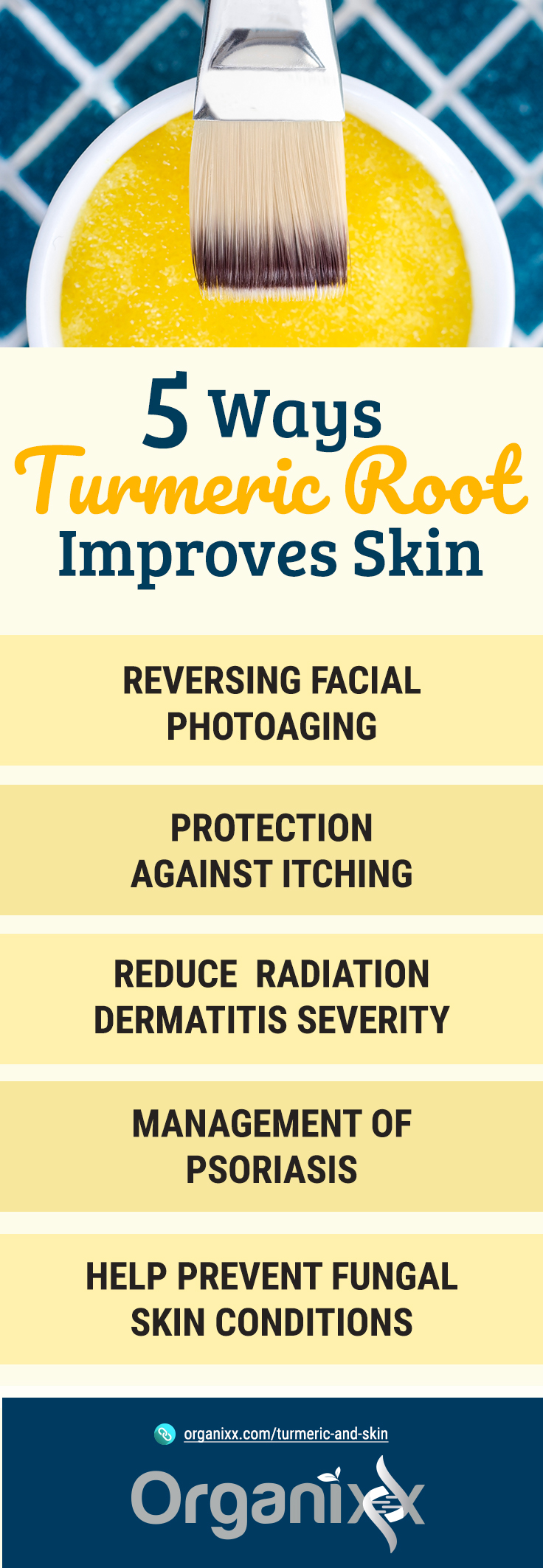
Potential Adverse Effects and Contraindications of Curcumin & Turmeric
With all the buzz about turmeric and its active compound curcumin, how safe is turmeric root considered to be?
Turmeric is considered extremely safe, especially when used in whole food form and as a spice for cooking. This is obvious from the fact that nearly all Indians and many other South Asians routinely use significant amounts of turmeric in their daily cooking for their entire lives without any reported adverse effects.
However, more care is likely needed when consuming fresh turmeric juice, turmeric essential oil, tinctures, and other therapeutic formulations containing turmeric, as well as turmeric supplements. This is because the dose of turmeric – and its various powerful active ingredients, including curcumin – can vary significantly in these preparations.
It has been reported that curcumin did not show any toxicity in doses as high as 8 grams daily for 3 months in a human clinical trial, making it a very safe and attractive supplement to support healthy inflammation levels.
In fact, there were no significant toxicities of curcumin reported from almost 40 clinical trials involving over 800 participants.
That being said, it must be noted that some clinical studies have shown isolated and transient rises in liver enzymes and anticoagulant properties with turmeric because of suppression of platelet aggregation.
With doses higher than 4 grams daily, isolated cases of gastrointestinal side effects have also been reported – including loose stools, acid reflux, bloating, and abdominal discomfort.
However, in a 2013 study of 26 patients given 2.35 grams of curcumin daily for 14 days, no serious adverse events attributable to curcumin and no changes in overall activity or general health were reported.
Patients in the study actually self-reported a decrease in gut-related disturbances including nausea, vomiting, constipation, diarrhea, flatulence, and abdominal pain following two weeks of daily curcumin intake. This suggests that curcumin may be beneficial for these conditions, rather than causing them.
In some instances, curcumin has been shown to stimulate gallbladder contractions, worsening symptoms in patients with gallstones. Further, curcumin has been shown to prevent the synthesis of Hepcidin, a protein involved in iron balance in the body. Perhaps as a result, curcumin has been shown to cause a dose-dependent drop in hematocrit, hemoglobin, and blood iron levels in people with an underlying subclinical iron deficiency or anemia.
Therefore, some health experts recommend that curcumin should be taken with caution by people with low iron stores in their body, or other diseases associated with iron such as anemia.
In conclusion, while most of the currently available research indicates that turmeric and its many active ingredients are extremely safe, it is recommended that you take fresh turmeric juice, turmeric oil, tinctures, and other therapeutic formulations containing turmeric, as well as turmeric supplements, under the supervision of a qualified healthcare provider.
Turmeric 3D from Organixx provides you one of the most “bioavailable” forms of turmeric due to its unique fermentation process. This means your body experiences the maximum benefits of the purest, most potent turmeric available!
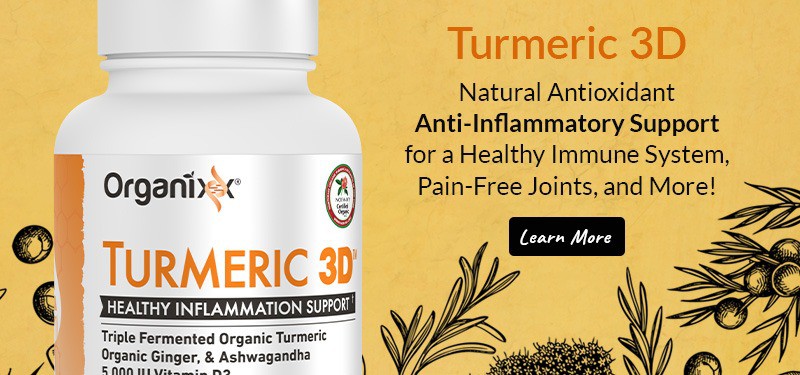
 Sources:
Sources:
Article Summary
Turmeric is an earthy root spice belonging to the ginger family and is popular for its potent health-giving benefits.
Some of the traditional uses of turmeric in Ayurveda, the traditional Indian system of medicine, include:
- Helping to maintain healthy levels of gut bacteria
- Protecting against stomach disorders
- Helping to cleanse the liver and increase the flow of bile, necessary for breaking down dietary fats during digestion
- Helping to manage blood sugar
- Helping to support a body plagued with arthritis inflammation and pain.
Turmeric’s ability to support healthy inflammation levels in the body is the reason why it benefits so many health conditions – including those affecting the skin.
Turmeric has scientifically been shown to improve skin by:
- Reversing facial photoaging
- Protection against itching
- Reducing severity of radiation dermatitis
- Management of psoriasis
- Helping to stop fungal skin conditions
Some health experts recommend that curcumin, Turmeric’s active compound, should be taken with caution by people with low iron stores in their body, or other diseases associated with iron such as anemia.
Turmeric is considered extremely safe, especially when used in whole food form and as a spice for cooking.


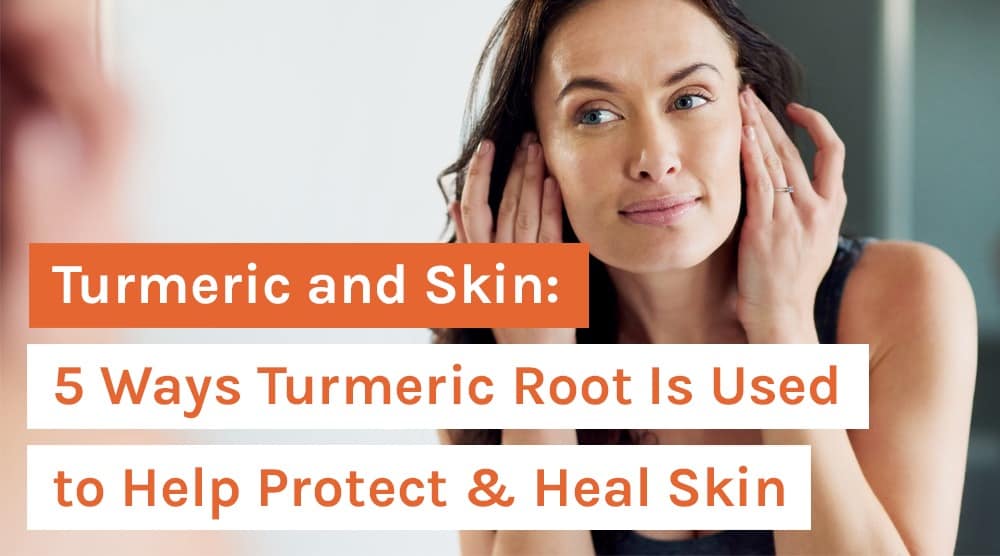
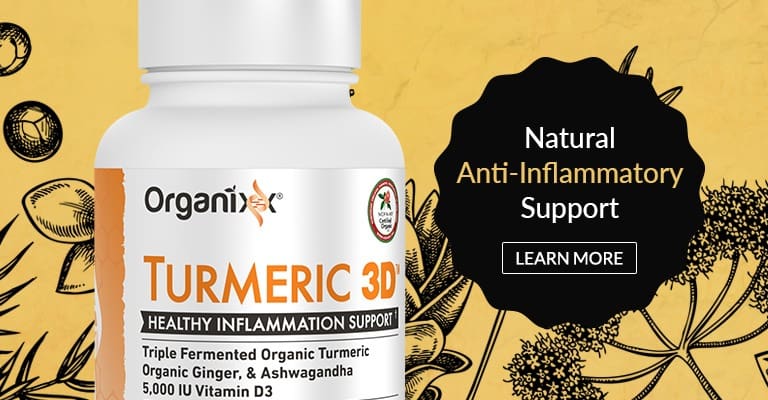


how do you use turmeric on yoiur face? do you mix it with water?
What about helping memory? I've
Read it's good for that.
Can this help with plantar warts? I have tried everything to get rid of them, but still have found nothing to get rid of these pesky buggers!!
Can turmeric oil be used under the eye? I have a cyst and I am wondering if turmeric would help. Thank you.
Thanks for your information. I never thought that radishes could protect my skin until I read this.